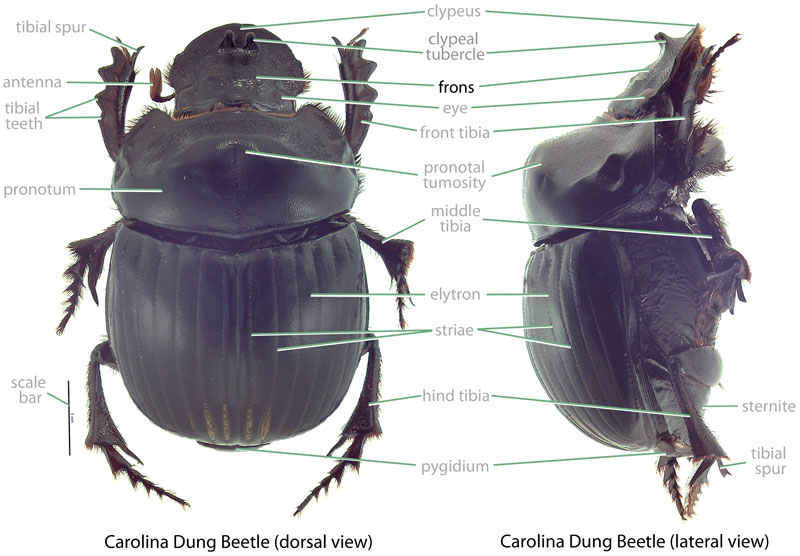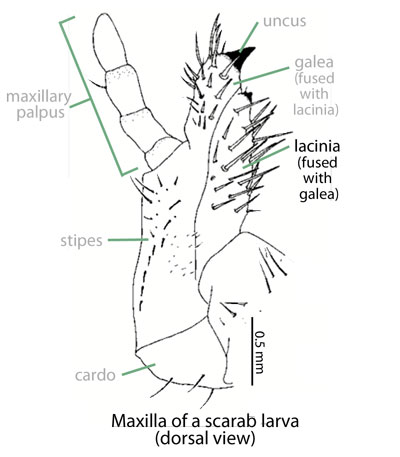Beneficial
intermediate sandy dung beetle
Family: Scarabaeidae Subfamily: Scarabaeinae Genus: Euoniticellus Species: Euoniticellus intermedius (Reiche, 1849)
none available
Total body length 6.5–9.5 cm (0.26–0.37 in). Body oblong, somewhat dorsoventrally compressed; make be caked in dung. Color tan to grayish-brown with dark brown markings. Clypeusclypeus:
part of the head anterior to the frons; the most anterior portion in dorsal view
 of male with distinct anterioranterior:
of male with distinct anterioranterior:
the front or forward; opposite of posterior
ridge; female lacking ridge. Frontoclypeal suturefrontoclypeal suture:
transverse suture between the clypeus and frons
of female quadratequadrate:
square-like in shape
, male suture indistinct. Fronsfrons:
part of the head generally positioned between the eyes (posterior to the clypeus and anterior to the vertex) and visible dorsally
 of male with peg-like horn; female lacking horn. Canthuscanthus:
of male with peg-like horn; female lacking horn. Canthuscanthus:
a process extending over and sometimes dividing the eye
quadrately produced. Pronotumpronotum:
the dorsal surface of the thorax
 of male somewhat hump-like when viewed laterally. Tibiatibia:
of male somewhat hump-like when viewed laterally. Tibiatibia:
a segment of the leg articulated with the tarsus and femur
 of female robust; male tibiatibia:
of female robust; male tibiatibia:
a segment of the leg articulated with the tarsus and femur
 comparatively gracilegracile:
comparatively gracilegracile:
thin, slender, light of build
.
(Blume, 1984Blume, 1984:
Blume R. 1984. Euoniticellus intermedius (Coleoptera: Scarabaeidae): description of adults and immatures and biology of adults. Environmental Entomology 13: 1064-1068. full text (accessed 2015)): Grub C-shaped, hump-backed, cylindrical, and cream-colored. Maxillamaxilla:
set of paired mouthparts located posterior to the mandibles
with galeagalea:
outer branch or lobe of the maxilla
 and lacinialacinia:
and lacinialacinia:
inner portion of the maxilla distinctly separate. Lacinialacinia:
distinctly separate. Lacinialacinia:
inner portion of the maxilla with uncusuncus:
with uncusuncus:
in scarab larvae, a hooked process on the distal margin of the maxilla
 lacking proximal teeth. Fronsfrons:
lacking proximal teeth. Fronsfrons:
part of the head generally positioned between the eyes (posterior to the clypeus and anterior to the vertex) and visible dorsally
 with both sides bearing single posteriorposterior:
with both sides bearing single posteriorposterior:
towards the rear end; opposite of anterior
frontal setaseta:
small, hair-like structure
. Chaetopariachaetoparia:
inner, bristle-covered portion of the paria
 composed of 12 or 13 setaesetae:
composed of 12 or 13 setaesetae:
small, hair-like structure
. TormaeTormae:
in scarab larvae, sclerotized structures on the ends of the clypeolateral suture extending towards the mesal line
symmetrical. Mesophobamesophoba:
the middle phoba
monostichous. Haptolachushaptolachus:
posterior of the epipharynx, behind the pedium
 with 4 macrosensillaemacrosensillae:
with 4 macrosensillaemacrosensillae:
small sensory spot(s) located on the epipharynx
at center. Mandiblemandible:
The crushing or chewing portion of an insects mouthparts
 with 2 lateral setae; left mandiblemandible:
with 2 lateral setae; left mandiblemandible:
The crushing or chewing portion of an insects mouthparts
 with 3 scissorial teeth, right mandiblemandible:
with 3 scissorial teeth, right mandiblemandible:
The crushing or chewing portion of an insects mouthparts
 with 2 scissorial teeth. Maxillary stridulatory area with 11 or 12 anteriorly pointing teeth. Glossaglossa:
with 2 scissorial teeth. Maxillary stridulatory area with 11 or 12 anteriorly pointing teeth. Glossaglossa:
paired terminal lobes of the labium
with transversetransverse:
extending horizontally across a surface
row of setaesetae:
small, hair-like structure
anterioranterior:
the front or forward; opposite of posterior
to the oncylioncyli:
in scarab larvae, pair of asymmetrical sclerotized processes on hypopharynx
. Legs 2-segmented; with terminal papillapapilla:
a small fleshy projection or rounded protuberance
bearing a single setaseta:
small, hair-like structure
. Prothoracic shieldprothoracic shield:
the chitinous plate behind the head of larvae
 lacking anterioranterior:
lacking anterioranterior:
the front or forward; opposite of posterior
projections. Rasterraster:
in scarab larvae, a complex of setose, spiny, and bare areas on the ventral surface of the last abdominal segment with tenth sternumsternum:
with tenth sternumsternum:
ventral surface of the thorax
bearing a central undivided patch of short, stout setaesetae:
small, hair-like structure
.
Africa and Arabia. This species is native to Africa from South Africa north to the Sahel. It is also known from the Arabian peninsula (Tyndale-Biscoe, 1990Tyndale-Biscoe, 1990:
Tyndale-Biscoe M. 1990. Common dung beetles in pastures of southeastern Australia. CSIRO Publishing, Clayton, Australia.). In the mainland U.S., this species was intentionally released in California, Texas, and Florida (Wood and Kaufman, 2008Wood and Kaufman, 2008:
Wood L and Kaufman P. 2008. Euoniticellus intermedius (Coleoptera: Scarabaeidae: Scarabaeinae: tribe Coprini): its presence and relative abundance in cattle pastures in north-central Florida. Florida Entomologist 91: 128-130. full text (accessed 2015)). It was also released in Australia (Tyndale-Biscoe, 1990Tyndale-Biscoe, 1990:
Tyndale-Biscoe M. 1990. Common dung beetles in pastures of southeastern Australia. CSIRO Publishing, Clayton, Australia.).
None. Euoniticellus spp. feed on dung as both adults and larvaelarvae:
the immature form of an insect; in scarabs, also called grub or white grub; preceded by the egg stage, followed by the pupal stage
 (Hull et al., 2013Hull et al., 2013:
(Hull et al., 2013Hull et al., 2013:
Hull R, Alaouna M, Khanyile L, Bryne M, Ntwasa M. 2013. Lifestyle and host defense mechanisms of the dung beetle, Euoniticellus intermedius : the toll signaling pathway. Journal of Insect Science 13: 1-25. full text (accessed 2015)).
Adults are found in variety of moist and semi-arid habitat types (Edwards, 2007Edwards, 2007:
Edwards P. 2007. Introduced dung beetles in Australia 1967-2007. Landcare Australia, Sydeny, New South Wales, Australia. full text (accessed 2015)), although they show some preference for open areas with clay-loam soils (Blume, 1984Blume, 1984:
Blume R. 1984. Euoniticellus intermedius (Coleoptera: Scarabaeidae): description of adults and immatures and biology of adults. Environmental Entomology 13: 1064-1068. full text (accessed 2015)). Adults are diurnaldiurnal:
active during daylight hours
with flight activity peaking between 2–5 pm. Adults are readily attracted to cattle dung but avoid pig feces (Blume, 1984Blume, 1984:
Blume R. 1984. Euoniticellus intermedius (Coleoptera: Scarabaeidae): description of adults and immatures and biology of adults. Environmental Entomology 13: 1064-1068. full text (accessed 2015)). Working together, a male and female dig a 7–15 cm (2.7–5.9 in) deep burrow beneath a dung source. Dung is used to line the burrow and create a 3.0–3.5 gram brood ball. The brood ball is created at the end of the burrow and impregnated with a single egg. Multiple brood masses, each with its own egg, can occupy the same burrow. The number of masses is dependent upon food availability, soil moisture, and temperature. Development from egg to adult takes five or six weeks. Adults live up to two months (Hull et al., 2013Hull et al., 2013:
Hull R, Alaouna M, Khanyile L, Bryne M, Ntwasa M. 2013. Lifestyle and host defense mechanisms of the dung beetle, Euoniticellus intermedius : the toll signaling pathway. Journal of Insect Science 13: 1-25. full text (accessed 2015)).
None. This species recycles dung and is beneficial for ranching and farming in Hawaii. Being a dung feeder, this species poses no threat to crop or ornamental plants. Additionally, this species is not a threat to native dung beetles because none are known from Hawaii or Guam.
Established. This dung beetle was intentionally released in 1974 at Parker Ranch on Big Island to help control populations of the horn fly (Haematobia irritans), a biting pest of livestock (Nakao and Funasaki, 1976Nakao and Funasaki, 1976:
Nakao H and Funasaki G. 1976. Introductions for biological control in Hawaii, 1974. Proceedings of the Hawaiian Entomological Society 22: 329-331. full text (accessed 2015)).
Not established or recorded. There are no records of this species from Guam.
In Hawaii, this species was intentionally introduced.
Euoniticellus intermedius is one of two Euoniticellus species known from Hawaii, the other recorded species being the very similar Euoniticellus africanus. The two scarabs can be separated by examination of the fronsfrons:
part of the head generally positioned between the eyes (posterior to the clypeus and anterior to the vertex) and visible dorsally
 (E. intermedius male with horn on the fronsfrons:
(E. intermedius male with horn on the fronsfrons:
part of the head generally positioned between the eyes (posterior to the clypeus and anterior to the vertex) and visible dorsally
 versus E. africanus male lacking a horn, instead with a v-shaped ridge) and frontoclypeal suturefrontoclypeal suture:
versus E. africanus male lacking a horn, instead with a v-shaped ridge) and frontoclypeal suturefrontoclypeal suture:
transverse suture between the clypeus and frons
(E. intermedius female with suture quadratequadrate:
square-like in shape
and male suture indistinct versus E. africanusfemale suture triangulate and male suture crescent shaped).
Oniticellus intermedius Reiche, Euoniticellus clavatus Roth, Euoniticellus nasicornis Peringuey, Euoniticellus pallens Laporte (Comte de Castelau), Euoniticellus speciosus Costa
Report your observation of this beneficial species at our iNaturalist project.